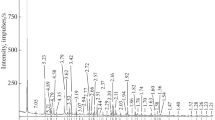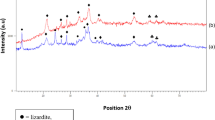Abstract
The enthalpies of formation of natural trioctahedral smectite from elements were determined for the first time by high-temperature melt solution calorimetry using Tian-Calvet microcalorimeter: Δ f H 0(298.15 K): −5799.1 ± 5.1 kJ/mol for saponite Ca0.1Na0.1K0.1(Mg2.6Fe 2+0.1 Fe 3+0.2 )[Si3.6Al0.4O10](OH)2 (Arkhangelsk diamond province) and −5937.3 ± 6.0 kJ/mol for saponite Ca0.4(Mg2.6Al0.2)[Si3.4Al0.6O10](OH)2 (Mt. Kukisvumchorr, Khibiny). The enthalpies of formation of magnesian and magnesium-iron saponites of theoretical composition were estimated.
Similar content being viewed by others
References
V. M. Apollonov, V. L. Bershova, V. K. Garanin, V. P. Grib, G. P. Kudryavtseva, and T. V. Posukhova, “Ecological aspects of mineralogical material science by the example of the Lomonosov diamond deposit,” Zap. Vseross. Mineral. O-va, No. 3, 1–6 (1992).
V. M. Apollonov, V. N. Verzhak, K. V. Garanin, V. K. Garanin, G. P. Kudryavtseva, and V. G. Shlykov, “Saponite from the Lomonosov diamond deposit,” Vestn. Mosk. Univ., Ser. 4: Geol., No. 2, 64–73 (2004).
P. N. Chirvinskii, “Saponite,” in Minerals of the Khibiny and Lovozero Tundras (Akad. Nauk SSSR, Moscow, 1937), pp. 286–287 [in Russian].
V. A. Drits and A. G. Kossovskaya, Clay Minerals: Smectites and Mixed-Layer Minerals (Moscow, Nauka, 1990) [in Russian].
H. Gailhanou, P. Blanc, J. Rogez, G. Mikaelian, H. Kawaji, J. Olives, M. Amouric, R. Denoyel, S. Bourrelly, V. Montouillout, P. Vieillard, C. I. Fialips, N. Michau, and E. Gaucher, “Thermodynamic properties of illite, smectite and beidellite by calorimetric methods: enthalpies of formation, heat capacities, entropies and Gibbs energies of formation,” Geochim. Cosmochim. Acta 89, 279–301 (2012).
H. Gailhanou, J. C. Miltenburg, J. Roges, J. Olives, M. Amouric, E. C. Gaucher, and P. Blanc, “Thermodynamic properties of anhydrous smectite MX-80, illite IMt-2 and mixedlayer illite-smectite ISCz-1 as determined by calorimetric methods. Part I: Heat capacities, heat contents and entropies,” Geochim. Cosmochim. Acta 71, 5463–5473 (2007).
V. P. Ivanova, B. K. Kasatov, T. N. Krasavina, and E. L. Rozinova, Thermal Analysis of Minerals and Rocks (Nedra, Leningrad, 1974) [in Russian].
I. A. Kiseleva and L. P. Ogorodova, “Application of high temperature dissolution calorimetry for determination the enthalpy of formation of hydroxyl-bearing minerals by the example of talc and tremolite,” Geokhimiya, No, 12, 1745–1755 (1983).
I. A. Kiseleva, L. P. Ogorodova, N. D. Topor, and O. G. Chigareva, “Thermochemical study of the CaO-MgO-SiO2 system,” Geokhimiya, No. 12, 1811–1825 (1979).
I. A. Kiseleva, “Thermodynamic properties and pyrope stability,” Geokhimiya, No. 6, 845–854 (1976).
I. A. Kiseleva, A. R. Kotelnikov, K. V. Martynov, L. P. Ogorodova, and Yu. K. Kabalov, “Thermodynamic properties of strontianite-witherite solid solution (Sr,Ba)CO3,” Phys. Chem. Miner. 21, 392–400 (1994).
I. A. Kiseleva, A. Navrotsky, I. A. Belitsky, and B. A. Fursenko, “Thermochemical study of calcium zeolites—heulandite and stilite,” Am. Mineral. 86, 448–455 (2001).
G. P. Kudryavtseva, A. V. Podgaetsku, K. V. Garanin, V. K. Garanin, V. N. Apollonov, A. T. Bondarenko, E. B. Bushueva, E. B. Verzhak, and E. M. Verichev, “Mineral composition and petrophysical properties of kimberlites and related rocks of the Zimnii Bereg,” Izv. Vyssh. Uch. Zaved., Geol. Razved., No. 3, 29–35 (2003).
L. P. Ogorodova, I. A. Kiseleva, L. V. Melchakova, M. F. Vigasina, and V. V. Krupskaya, “Thermochemical study of natural montmorillonite,” Geochem. Int. 51(6), 484–494 (2013).
A. Navrotsky and W. J. Coons, “Thermochemistry of some pyroxenes and related compounds,” Geochim. Cosmochim. Acta 40, 1281–1295 (1976).
L. P. Ogorodova, I. A. Kiseleva, L. V. Melchakova, M. F. Vigasina, and E. M. Spiridonov, “Enthalpy of formation of talc Mg3[Si4O10](OH)2 according to dissolution calorimetry,” Russ. J. Phys. Chem. 85(9), 1489–1491 (2011).
L. P. Ogorodova, L. V. Melchakova, I. A. Kiseleva, and I. A. Belitsky, “Thermodynamic properties of natural erionite based on calorimetric data,” Vestn. Mosk. Univ., Ser. 4: Geol., No. 6, 55–58 (2001).
L. P. Ogorodova, L. V. Melchakova, I. A. Kiseleva, and I. A. Belitsky, “Thermochemical study of natural pollucite,” Thermochim. Acta, 403, 251–256 (2003).
O. Omotoso, D. K. McCarty, R. Kleeberg, and S. Hillier, “Some successful approaches to quantitative mineral analysis as revealed by the 3rd Reynolds cup contest,” Clays Clay Miner. 54(6), 748–760 (2006).
N. V. Posukhova, S. A. Dorofeev, K. V Garanin, and Gao Siaoin, “Diamond industry wastes: mineral composition and recycling,” Mosk. Univ. Geol. Bull. 68(2), 96–107 (2013).
R. A. Robie and B. S. Hemingway, “Thermodynamic properties of minerals and related substances at 298.15 K and 1 bar (105 pascals) pressure and at higher temperatures,” U.S. Geol. Surv. Bull., No. 2131, (1995).
H. W. Van der Marel and H. Beutelspacher, Atlas of Infrared Spectroscopy of Clay Minerals and Their Admixtures (Elsevier, Amsterdam-Oxford-New York, 1976).
O. Vidal and B. Dubacq, “Thermodynamic modeling of clay dehydration, stability and compositional evolution with temperature, pressure and H2O activity,” Geochim. Cosmochim. Acta 73, 6544–6564 (2009).
P. Vieillard, “A new method for the prediction of Gibbs free energies of formation of hydrated clay minerals based on the electronegativity scale,” Clays Clay Miner. 48(4), 459–473 (2000).
Author information
Authors and Affiliations
Corresponding author
Additional information
Original Russian Text © L.P. Ogorodova, I.A. Kiseleva, L.V. Mel’chakova, M.F. Vigasina, V.V. Krupskaya, V.V. Sud’in, 2015, published in Geokhimiya, 2015, No. 7, pp. 617–623.
Rights and permissions
About this article
Cite this article
Ogorodova, L.P., Kiseleva, I.A., Mel’chakova, L.V. et al. Calorimetric determination of the enthalpy of formation of natural saponite. Geochem. Int. 53, 617–623 (2015). https://doi.org/10.1134/S0016702915070071
Received:
Accepted:
Published:
Issue Date:
DOI: https://doi.org/10.1134/S0016702915070071




